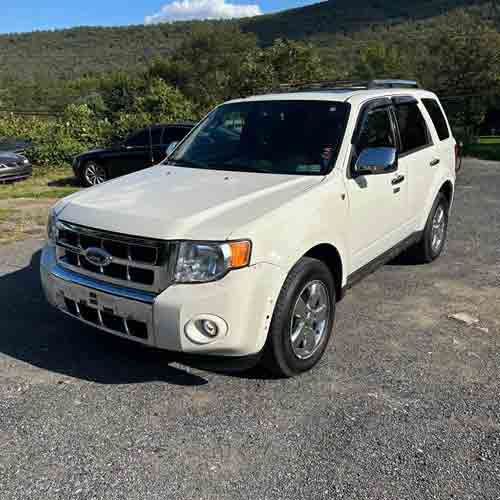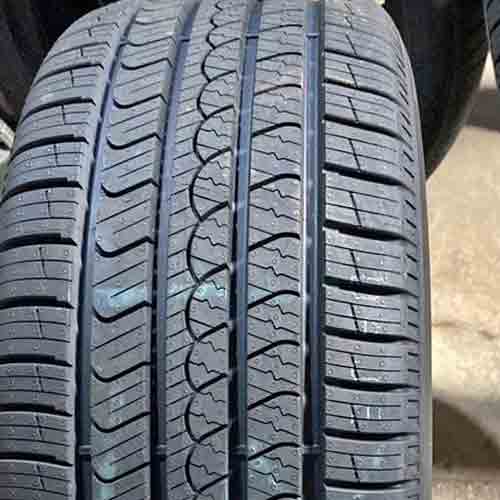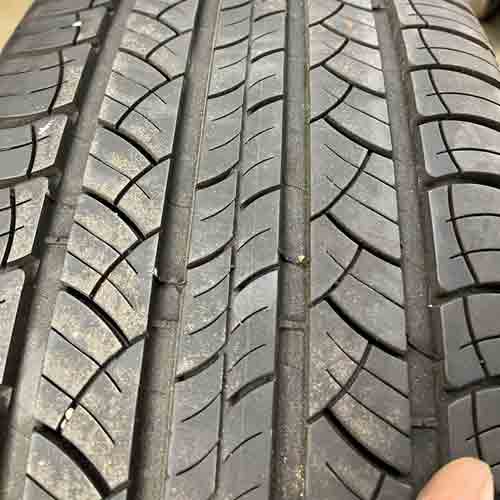The battle of highway performance is on as Pirelli’s Scorpion AS Plus 3 challenges Michelin’s Latitude Tour HP. Both tires offer superior handling and comfort, but the choice boils down to specific driving conditions and needs. Let’s begin.

As a tire engineer, my tests reveal that the Michelin Latitude Tour HP excels in dry conditions but struggles with wet traction and noise. In contrast, the Pirelli Scorpion AS Plus 3 is superior in wet conditions, noise insulation, and comfort due to its design. And yes, while Pirelli offers better snow grip and longevity, Michelin has a better bite on ice.
Tire Sizes
The Michelin Latitude Tour HP comes in 16 to 22 inches rims, and they have the following specs.
- Speed ratings: H, V, W, and Y.
- Load ratings: SL and XL.
- Tread depth range: 9 to 10/32″.
- Weight range: 27 to 43 lbs.
- Treadwear warranty: 55k miles for H and V rated sizes, and 45k for W, and Y speed rated ones.
- UTQG rating: 440 A B.
For Your Info: Let me clear something, many people inquire me about. And that’s the difference between the Latitude Tour and the Tour HP. While they appear similar externally, the Latitude Tour gives a lower speed rating and a tread depth that’s nearly 2/32″ more. This results in extended mileage, backed by a 65k warranty and a UTQG rating of 720 A B (of the simple Latitude Tour model).
On the other side, the Pirelli Scorpion AS Plus 3 comes in 17 to 22 inches wheels. And all of those sizes have following specifications.
- Speed ratings: T, H and V.
- Load ratings: SL and XL.
- Tread depth: 11/32″ on all.
- Weight range: 29 to 42 lbs.
- Treadwear warranty: 70k miles.
- UTQG rating: 800 A A.
Tread Structure
The Pirelli Scorpion comes with an asymmetric tread pattern, with multiple design elements aimed at maximizing performance, comfort, and safety.

Now the whole structure is comprised of 5 ribs, where the 3 central ribs make 4 longitudinal grooves with the outer 2 shoulder ribs.
The shoulder lugs are the least biting, where you also see lateral grooves, minor off-set edges and lateral longitudinal slits along with lateral siping.
The central part is a bit more complicated where you see a mixture of linear and interlocking (wave-like) siping.
While the middle rib has both these features a long with curved in-groove notches, the adjacent ribs only carry a single siping pattern.
Though both adjacent ribs have curved lateral grooves.
Internally, the tire offers 2 ply polyester casing with 2 steel belts and a 2 ply nylon cap plies.
On the other side, the Michelin Latitude Tour HP comes with a symmetric tread pattern, though like most all season tires, including Pirelli, its also structured with 5 ribs.

Now, here the 4 circumferential channels the ribs make are more, you can say, tough passing.
This is mainly because of the off-set edges of the lugs on all ribs, predominately on the central most one.
Speaking of which this rib carries curved in-groove notches and wave-like siping.
While the adjacent ribs although have similar features, with interlocking grooves (they make), they offer a lot more biters.
And same goes for shoulders, which are also not as aggressive as those ribs.
Internally, the tire offers a single ply carcass, with twin belts, and spirally wound nylon cap ply, having Michelin’s FAZ technology.
FAZ basically winds nylon cap ply in a way to enhance tire’s handling stability.
Wet Traction
When assessing wet traction, both tires present distinct performances.
The Latitude Tour HP, though exceptional on dry roads, faces challenges in wet conditions, where its limited traction leads to a noticeable slippage.
I mean the tire understeers, particularly when trying to regain control.
Basically the tire features a relatively harder rubber blend, which restricts the sipes from flexing as they should.
And as sipes absorb and expel water by flexing, generating a suction effect that enhances grip, Michelin with a rigid composition, limits the tire’s ability to expel water efficiently.
On the other side, although the Pirelli Scorpion AS Plus 3 also faces some slippage, it still emerges as a more consistent performer in wet conditions.
It’s full depth sipes having both linear and wave-like patterns, combined with its softer overall tread provide better handling and braking overall.
Hydroplaning Resistance
Hydroplaning is simply a term used, when a tire starts to float on water (as its not able to channel water out in time).
And to counter this, tires come with spacious grooves designed to channel out water swiftly.
Though it gets more and more difficult as the tire speeds up, that’s why the overall hydro or aquaplaning resistance is measured by how fast a tire can roll over watery surface. (Which is a definition of float speed, actually).
Now although both tires are doing great here, offering decent straight float speeds, the Pirelli Scorpion AS Plus 3 still takes the upper hand, mainly because of its slightly more voided up structure, and greater tread depth, so more water is thrown out in this tire’s case.
Dry Performance
The efficacy of a tire’s grip in dry tracks depends on factors like its construction, material, and tread composition.
And here the Michelin Latitude Tour HP excels across multiple performance parameters, offering better directional grip, steering responsiveness, and overall handling.
Directional Grip
The tire’s straight line or directional grip is measured by braking distances, and is basically dependent on the tire’s central region. This is because, during straight-line motion, the tire’s middle section bears the most weight of the vehicle/tire itself.
In this regard, the Michelin Latitude Tour HP offers better traction, owing to its continuous running of three central ribs, coupled with multi-directional biters or in-groove notches.
On the other side, although the Pirelli Scorpion AS Plus 3 also exhibits satisfactory results, but it still lacks to its counterpart.
I mean, its compact central area (having similar 3 streamlined ribs), with reinforced foundations, provide above average directional traction overall, with a more voided up structure, it can’t offer as much rubber to road contact.
Dry Cornering Grip
Cornering depends on shoulders, as they get the most weight pressure on them as the tire turns. Now here, although the Pirelli Scorpion AS Plus offers superior lateral traction, its overall handling times are still slower.
So why is this happening?
Well, this is because traction is only half the equation, and overall performance comes from considering the tire’s steering. And here Pirelli isn’t able to offer as balanced under/oversteering.
Whereas the Michelin Latitude Tour HP with its stiffer rubber, and spirally wound nylon cap plies offers a razor-sharp steering.
It brakes quicker entering the turns, its mid corner feedback is faster, and exiting the corner it also provides greater stability with its nicely weighted on-center feel.
And combing all these aspects, you get a faster laps with this tire on average.
Winter Performance
When assessing the winter capabilities of an all-season tire, we mainly look at three key factors:
- The tire’s acceleration.
- Its handling, especially in terms of steering response.
- Its performance on different terrains, with special emphasis on soft snow and ice.
Now, here we have some mixed results, where the Michelin tire excels in ice traction, while the Pirelli stands out in snow conditions.
The Michelin’s better ice grip basically comes form its abundant interlocking sipes distributed throughout the tread, and as they have a multi-directional orientation, the tire offers ice traction from all angles.
On the other hand, the Pirelli Scorpion AS Plus 3, despite showing minor shortcomings in braking and overall handling (on ice), due to a tendency to understeer, offers outstanding snow traction.
Its biters effectively grab the ground, improving snow-to-snow contact. This is noteworthy since snowflakes mesh well together, providing a stronger grip than snow-to-rubber contact.
Note: Both tires don’t offer the 3 peak mountain snowflake rating.
Tread Life
In terms of tread lifespan, the Michelin Latitude Tour HP although does pretty great with its durable silica-based tread rubber, ensuring respectable wear resistance, the tire still lacks to its counterpart.
So, why is Pirelli better here?
Well, it comes down to three main factors: tread depth, compound composition, and the construction’s overall weight.
While the Latitude Tour HP caps at a 10/32″ tread depth, the Pirelli offers an additional 1/32″ across all its sizes, means it takes longer to wear down to the point of needing replacement.
Additionally although Scoripion AS Plus has a softer rubber, its lugs lugs are still fortified with reinforced bases, limiting their flexibility. This results in less heat production and slower wear.
So it makes sense that, while Michelin guarantees up to 55,000 miles, Pirelli confidently promises up to 70,000 miles (referring to treadwear warranties).
Though don’t get me wrong, considering Latitude Tour HP’s grip, the tire is still doing pretty great, with its lighter single-ply polyester internal makeup, and MaxTouch technology (which ensures that forces during contact spread out evenly across the tire).
Fuel Efficiency
The fuel efficiency of the Scorpion AS Plus 3 stands out, relatively speaking.
This tire offers a lower rolling resistance, thanks to its reasonably lightweight construction and the efficiently designed central ribs.
While the lugs of this tire may seem softer and possibly more adhesive than those of its competitors (including of course Michelin here), their reinforced bases ensure they remain firm under pressure.
And that minimizes tread flexing which wastes energy.
Moreover, the tire is equipped with a more streamlined structure with less overall biters, allowing for easier rolling.
In contrast, the Latitude Tour HP, although with its single-ply lightweight build, optimal tread depth, and reinforced lug foundations, also limits this lug flexing, the tire lacks due to its grip.
You see grip comes at a cost as its directly proportional to rolling resistance, and the tire with greater biters offering superior grip gets to lack here.
Noise Dampening Ability
So overall Pirelli offers a more comfortable ride, when it comes to noise.
It only comes out with a subtle white noise, heard at lower speeds, though on highways, there’s a pronounced tone that tends to blend with the background.
And yes, there’s also distinct sound interplay between the tread and the road, especially on entry and exit ramps.
But even so, the overall acoustic qualities of this tire is more favorable in comparison, as the Michelin Latitude Tour exhibits more noticeable noise, where it emits a discernible two-tone cavity sound, predominately, I mean.
Basically its tread is the cause here, with so much siping and not as effective variable pitch pattern, the tire crates a mix of lower and higher-pitched tones/grinds.
(Variable pitch pattern basically produces a varied sound frequencies at different points. And this diversity prevents sounds from accumulating, leading to a notable decrease in overall noise).
Now Pirelli Scorpion AS Plus 3 not only has a more sophisticated variable pitch technology, the tire is also not as siped up, and its composition soaks up more sound waves, so overall in-groove resonance is lower in comparison.
Ride Smoothness
The comfort of a tire ride largely depends on its ability to effectively handle surface imperfections.
And in this regard, the Michelin Latitude Tour HP might need some improvement.
I mean, while its hard nylon cap ply with a spirally wound structure provides great stability and smooth cornering, it doesn’t fare as well in reducing road vibrations.
Whereas the Pirelli Scorpion AS Plus 3, with its softer rubber composition, excels at dampening road vibrations, where it smoothly handles minor bumps, making them barely noticeable.
And even though the tire struggles a bit with larger impacts, meaning its softer compound takes longer to recover after the impact, the overall subjective comfort is better on this tire, still.
So what’s the verdict?
So overall, both tires offer various strengths and areas for improvement.
The Michelin excels in dry conditions, particularly in directional grip and cornering, thanks to its tread design and rigid construction. However, it struggles in wet conditions and noise dampening.
The Pirelli, on the other hand, demonstrates great wet traction and hydroplaning resistance due to its siping design and deeper tread depth. Its softer rubber composition provides superior noise insulation and smoother rides over minor road imperfections.
Yet, it takes a slight hit in managing larger impacts, where its competitor is more stable.
Speaking of which, the Michelin also offers superior durability, though its superior grip results in greater rolling resistance which puts it back in terms of fuel and tread economy.